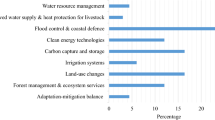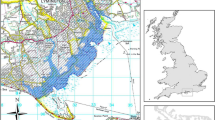Abstract
Investments in climate-change adaptation will have to be made while the extent of climate change is uncertain. However, some important sources of uncertainty will fall over time as more climate data become available. This paper investigates the effect on optimal investment decision-making of learning that reduces uncertainty. It develops a simple real options method to value options that are found in many climate-change adaptation contexts. This method modifies a binomial tree model frequently applied to climate-change adaptation problems, incorporating gradual learning using a Bayesian updating process driven by new observations of extreme events. It is used to investigate the timing, scale, or upgradable design of an adaptation project. Recognition that we might have more or different information in the future makes flexibility valuable. The amount of value added by flexibility and the ways in which flexibility should be exploited depend on how fast we learn about climate change. When learning will occur quickly, the value of the option to delay investment is high. When learning will occur slowly, the value of the option to build a small low-risk project instead of a large high-risk one is high. For intermediate cases, the option to build a small project that can be expanded in the future is high. The approach in this paper can support efficient decision-making on adaptation projects by anticipating that we gradually learn about climate change by the recurrence of extreme events.



Similar content being viewed by others
Notes
This structure is general enough to incorporate a wide variety of aspects of climate change including changes in temperature, rainfall, and sea level, and the occurrence of extreme events such as heat waves and storms.
Recent research suggests that meaningful learning about some important aspects of climate change can occur in 20–50 years (Urban et al. 2014; Lee et al. 2017). However, intra-regime variability means that learning about some aspects of climate change, such as local sea-level rise, will be much slower (Kopp et al. 2014).
The closely related methods of cost-effectiveness analysis and multi-criteria analysis also do not deal with flexibility, but unlike cost–benefit analysis they do not require all future benefits of adaptation projects to be monetized.
Erfani et al. (2018) use a multinomial tree in their analysis of water-supply planning.
The magnitude of Cu and Cp will reflect expected disruption costs due to delays, lost production, and general inconvenience caused by the event as well as the direct cost of repairing damaged infrastructure. We summarize the results of the extensive analysis that would normally be carried out to estimate the economic costs of extreme weather events into simple lump-sum expenditures of Cu and Cp. For examples of the sort of analysis that is possible, see Linquiti and Vonortas (2012) and Dawson et al. (2018).
We use the actual probabilities of up and down moves to calculate the expected payoff, so that all risk adjustment occurs via the discount rate.
In terms of the notation in Section 4, π1 = 0.05, π2 = 0.20, r = 0.05, α0 = 0.5, and Cu = 20.
The expected value of event-related costs incurred while the project is being built equals 2.50. The present value of all subsequent costs equals 1.375/0.05 = 27.50.
This comprises capital expenditure of 16 and ongoing costs with a present value of 30.
In practice, planners may not reevaluate a project each year, especially if learning about climate is a slow process. In this case, V (i, n) equals the expression in Eq. 4 in years when the project is not reevaluated.
For each value of α0, we solve the model using a binomial tree with 100 annual time steps. At each terminal node, V (i, n) equals the minimum of the present values if we invest immediately and if we never invest. At all other nodes, V (i, n) equals the expression in Eq. 5.
The specific example in this section is one of many possible examples of sequential investment. However, it features the most important properties of this type of investment. The decision-maker can gradually increase the scale of the project as new information becomes available, but it is costly to decrease the scale in response to new information. Gradual investment reduces the risk of investing in a project that is too large for the true scale of the problem being addressed, but doing so means that we incur high event-related costs in the short term.
In all cases, the project specifications are the same as in Section 5.
Analyzing a model with more than two climate regimes is more straightforward because all the calculations can be done with a single binomial tree. We simply need to specify all of the regime probabilities αk(i, n) at each node of this tree.
The only additional information needed is some measure of the initial uncertainty about climate change. Standard cost–benefit analysis effectively requires us to specify the perceived probability that an event occurs each period. We also need to specify the number of climate scenarios, the probability of events occurring in each scenario, and the probability that each of those scenarios applies.
References
Auffhammer M (2018) Quantifying economic damages from climate change. J Econ Perspect 32(4):33–52
Buurman J, Babovic V (2016) Adaptation pathways and real options analysis: an approach to deep uncertainty in climate change adaptation policies. Policy and Society 35(2):137–150
Dawson DA, Hunt A, Shaw J, Gehrels WR (2018) The economic value of climate information in adaptation decisions: learning in the sea-level rise and coastal infrastructure context. Ecol Econ 150:1–10
De Bruin K, Ansink E (2011) Investment in flood protection measures under climate change uncertainty. Climate Change Economics 2(4):321–339
Erfani T, Pachos K, Harou JJ (2018) Real-options water supply planning: multistage scenario trees for adaptive and flexible capacity expansion under probabilistic climate change uncertainty. Water Resour Res 54:5069–5087
Gersonius B, Ashley R, Pathirana A, Zevenbergen C (2013) Climate change uncertainty: building flexibility into water and flood risk infrastructure. Clim Chang 116(2):411–423
Groves DG, Lempert RJ (2007) A new analytic method for finding policy-relevant scenarios. Glob Environ Chang 17(1):73–85
Guthrie G (2009) Real options in theory and practice. Oxford University Press, New York
Haasnoot M, Middelkoop H, Offermans A, van Beek E, van Deursen WPA (2012) Exploring pathways for sustainable water management in river deltas in a changing environment. Clim Chang 115(3–4):795– 819
Haasnoot M, Kwakkel JH, Walker WE, ter Maat J (2013) Dynamic adaptive policy pathways: a method for crafting robust decisions for a deeply uncertain world. Glob Environ Chang 23:485–498
Haer T, Botzen WJW, van Roomen V, Connor H, Zavala-Hidalgo J, Eilander DM, Ward PJ (2018) Coastal and river flood risk analyses for guiding economically optimal flood adaptation policies: a country-scale study for Mexico. Philos Trans R Soc A Math Phys Eng Sci 376(2121):20170329
Helgeson C (2018) Structuring decisions under deep uncertainty. Topoi, forthcoming
Hsiang S, Kopp RE (2018) An economist’s guide to climate change science. J Econ Perspect 32(4):3–32
Kind JM, Baayen JH, Botzen WJW (2018) Benefits and limitations of real options analysis for the practice of river flood risk management. Water Resour Res 54 (4):3018–3036
Kontogianni A, Tourkolias C, Damigos D, Skourtos M (2014) Assessing sea level rise costs and adaptation benefits under uncertainty in Greece. Environ Sci Policy 37:61–78
Kopp RE, Horton RM, Little CM, Mitrovica JX, Oppenheimer M, Rasmussen DJ, Strauss BH, Tebaldi C (2014) Probabilistic 21st and 22nd century sea-level projections at a global network of tide-gauge sites. Earth’s Future 2(8):383–406
Lee BS, Haran M, Keller K (2017) Multidecadal scale detection time for potentially increasing Atlantic storm surges in a warming climate. Geophys Res Lett 44(10):617–623
Lempert RJ (2014) Embedding (some) benefit–cost concepts into decision support processes with deep uncertainty. Journal of Benefit–Cost Analysis 5(3):487–514
Linquiti P, Vonortas N (2012) The value of flexibility in adapting to climate change: a real options analysis of investments in coastal defense. Climate Change Economics 3 (2):1–33
Narita D, Quaas MF (2014) Adaptation to climate change and climate variability: do it now or wait and see? Climate Change Economics 5(4):1450013
Ramm TD, Watson CS, White CJ (2018) Describing adaptation tipping points in coastal flood risk management. Comput Environ Urban Syst 69:74–86
Ryu Y, Kim Y-O, Seo SB, Seo IW (2018) Application of real option analysis for planning under climate change uncertainty: a case study for evaluation of flood mitigation plans in Korea. Mitig Adapt Strat Glob Chang 23(6):803–819
Tee J, Scarpa R, Marsh D, Guthrie G (2014) Forest valuation under the New Zealand emissions trading scheme: a real options binomial tree with stochastic carbon and timber prices. Land Econ 90(1):44– 60
UNEP (2016) The adaptation finance gap report 2016. United Nations Environment Programme. Nairobi
UNFCCC (2007) Climate change: impacts, vulnerabilities, and adaptation in developing countries. United Nations Framework Convention on Climate Change. Bonn, Germany
Urban NM, Holden PB, Edwards NR, Sriver RL, Keller K (2014) Historical and future learning about climate sensitivity. Geophys Res Lett 41:2543–2552
van der Pol TD, van Ierland EC, Weikard H (2014) Optimal dike investments under uncertainty and learning about increasing water levels. J Flood Risk Manage 7(4):308–318
van der Pol TD, van Ierland EC, Gabbert S (2017) Economic analysis of adaptive strategies for flood risk management under climate change. Mitig Adapt Strateg Glob Chang 22(2):267–285
Watkiss P, Hunt A, Blyth W, Dyszynski J (2015) The use of new economic decision support tools for adaptation assessment: a review of methods and applications, towards guidance on applicability. Clim Chang 132(3):401–416
Woodward M, Gouldby B, Kapelan Z, Khu ST, Townend I (2011) Real options in flood risk management decision making. J Flood Risk Manage 4(4):339–349
Woodward M, Kapelan Z, Gouldby B (2014) Adaptive flood risk management under climate change uncertainty using real options and optimization. Risk Anal 34 (1):75–92
Zwaneveld P, Verweij G, van Hoesel S (2018) Safe dike heights at minimal costs: an integer programming approach. Eur J Oper Res 270:294–301
Acknowledgments
The author gratefully acknowledges extremely helpful suggestions from three anonymous referees.
Author information
Authors and Affiliations
Corresponding author
Additional information
Publisher’s note
Springer Nature remains neutral with regard to jurisdictional claims in published maps and institutional affiliations.
Appendix: Derivations
Appendix: Derivations
If an extreme weather event occurs in the next period then we update the probability that the bad scenario applies to
In contrast, if an event does not occur then our updated probability equals
Equivalently, the odds the good scenario applies decrease to
if an event occurs and increase to
if one does not occur. That is, we multiply the odds of the good scenario applying by π1/π2 each period that an event occurs, and by (1 − π1)/(1 − π2) each period one does not occur. It follows that if we initially believe the bad scenario applies with probability α0 and if i of the next n periods are free of events, we will have revised this probability to the number α(i, n) defined implicitly by
Equivalently,
The probability that an event will occur this period if i of the previous n periods are free of such events therefore equals
where the relationship between α0 and the three storm probabilities explains the final step.
Rights and permissions
About this article
Cite this article
Guthrie, G. Real options analysis of climate-change adaptation: investment flexibility and extreme weather events. Climatic Change 156, 231–253 (2019). https://doi.org/10.1007/s10584-019-02529-z
Received:
Accepted:
Published:
Issue Date:
DOI: https://doi.org/10.1007/s10584-019-02529-z




